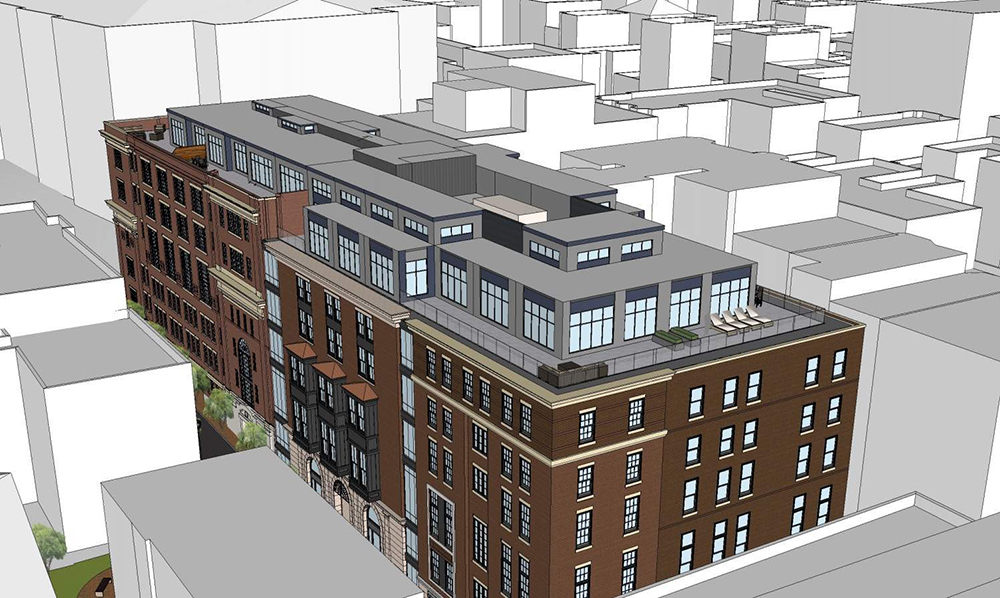
Boston, MA In the city’s historic Beacon Hill neighborhood, a unique adaptive reuse project is unlocking unexpected and appealing new housing opportunities, thanks to an inventive design by multifamily expert The Architectural Team (TAT).
Known as The Archer Residences, the 62-unit condominium development transforms two six-story former university buildings into a single, 172,000 s/f property topped off with a pair of contemporary penthouse additions and a landscaped roof terrace. Led by developers CCM and located on a prime site just a few blocks from Boston Common and the landmark Massachusetts State House, the residences will debut early next year as some of the city’s most desirable new homes.
“A site of this scale is hard to find in dense central Boston, and with preserved original brickwork and 14-foot windows, it’s a very different residential experience than you’d have in a newer district such as the Seaport,” said TAT associate Jay Szymanski, AIA, NCARB, LEED AP.
Szymanski adds, “The adaptive reuse approach taps into a market desire for authenticity and charm while opening an opportunity to live in one of the city’s most historic and attractive neighborhoods. And as Midcentury Modern buildings continue to gain appreciation from the public, our restoration of The Archer Residences’ 1960s addition highlights this appealing DNA, offering a great location with top amenities and generously sized homes.”
TWO BUILDINGS BECOME ONE
The large-scale conversion process required a different approach for each of its two buildings. Known for extensive preservation expertise, the TAT design team guided the restoration of decorative concrete panels and restored exterior brickwork on the oldest structure, dating from the 1920s. For the second building, constructed in the 1960s, TAT replaced the original façade with new cladding in a historically inspired palette of red brick, granite and bronzed steel – inspired by the buildings’ original design.
TAT also worked to make The Archer Residences compatible with its predominantly four-story neighbors, according to project manager Matt Duggan, AIA.
“We designed the more recent building’s new façade with a line of horizontal ribbon windows on the fifth and sixth floors, reinforcing a visual cornice line at the fourth story that aligns with the adjacent buildings on either side of the street,” said Duggan.
Reflecting the neighborhood’s textures, materials and colors, the penthouse additions are largely unseen from the street. “Our design also includes an extensive roof garden, which is not only a popular trend in contemporary multifamily design, but also draws on one of Le Corbusier’s Five Points Towards a New Architecture,” continues Duggan, who notes that these key Modernist principles informed TAT’s approach to The Archer Residences.
MIDCENTURY HISTORIC
According to the architects, while the project highlights the enduring appeal of older buildings, it also signals an emerging shift in the definitions of what constitutes an historically significant property in the first place.
“We often think of historic residential conversions as referring to industrial lofts or factory structures from the 19th or early 20th centuries,” notes TAT’s Szymanski. “Yet, even this 1960s institutional building is now within the eligibility period for historic designations, and we’re seeing a greater appreciation for these midcentury properties as valuable architectural assets, from both the design community and the public.”
The Archer Residences feature interiors by LDa Architecture & Interiors, with market-leading finishes and a mix of one-, two- and three-bedroom condominium homes, in addition to the penthouse units. Shared amenities include the roof terrace, a playroom, club room lounge, fitness center, pet spa and bicycle storage.
Unique for this dense urban setting, TAT’s design also provides for 50 below-grade parking spots, serviced by a 24-hour valet and accessed via a vehicle elevator. The compact and efficient parking system uses tandem car stackers, making the most of what was once a subterranean university cafeteria.
 (1).jpg)







.png)